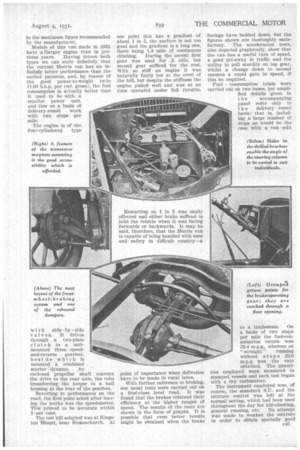A CAPABLE VAN
Page 66

Page 67

If you've noticed an error in this article please click here to report it so we can fix it.
from COWLEY
The Inexpensive Morris 81 0-ctot.
Van Put Through
Its Paces. A Use
All-round Per
formance by a
Vehicle of Sound Cons/ruction
°N.-4 of the most popular light ccinomercial vehicles in use by tradesmen throughout t h e country is the Morris light van, which is now rated as of 8-10-cwt. capacity. This is a useful load for delivery work from shops to private houses, etc., and the standard body, as provided on the vehicle tested, has a capacity of 78 cubic ft. The interior dimensions are :—Width, 4 ft.; length, 4 ft. 9 ins.; height, 4 ft. 3 ins. The maker is, of course, Morris Motors, Ltd., Cowley, Oxford.
Access to the load can be had through the double doors at the rear, in which are provided fixed windows and louvre-type ventilators. In addition, the driver can reach a large proportion of the load by turning around on the seat and reaching over the rail. Ample space is afforded for a van body behind him. There are two doors to the driving compartment, each equipped with a wind-up window with Triplex glass, and the screen embodies the same material.
As regards the body, we found that it was entirely free from rattles and drumming. There were no internal projections likely to damage loads, and the rear doors could be fastened both top and bottom, so that noise from this source was eliminated. The only improvement which we can suggest in connection with the body would be slightly wider doors to facilitate entry and egress. Ventilation is effected by an adjustable hatch in c44 the centre of the scuttle, controllable from the inside.
Turning now to the chassis and its general performance, it should be noted that the vehicle tested was brand new ; it had covered only a few miles during its preliminary road test. It was, however, put through our usual comprehensive one-day trial ; but, in deference to the, stiffness of the engine and in order not to cause damage to the vehicle, we refrained from testing it for Maximum speed. By calculation the maximum pace would be somewhat over 50 m.p.h., and our knowledge of the behaviour, in private hands, of this model confirms this figure.
On the weighbridge it was ascertained that the vehicle unladen weighed 19 cwt. 3 qrs. The test load employed, plus the weight of our representative—a second man would not normally be carried on a vehicle of this kind—amounted to 9 cwt. 2 qrs., so that it was laden almost
to the maximum figure recommended by the manufacturer.
Models of this van made in 1931 have :allarger engine than in pre
vious years. Having driven both types we can state definitely. that the current Morris van has an infinitely better performance than the earlier patterns, and, by reason of . the good power-to-weight ratio (1.06 b.h.p. per cwt. gross), the fuel consumption is actually better than it used to be with a smaller power unit, and this on a basis of
delivery-round work with two stops per mile.
The engine is of the four-cylindered type with side -by side valve s. It drives through a two-plate • clutch to a unitmounted three speedand-reverse gearbox, beside which is mounted a combined starter dynamo. An enclosed propeller shaft conveys the drive to the rear axle, the tube transferring the torque to a ball housing at the rear of the gearbox.
Reverting to performance on the road, the first point noted after leaving the works was the speedometer. This proved to be accurate within 1 •per cent.
The test hill selected was at Kingston Mount, near Stokenchurch. At
one point this has a gradient of about 1 in 5, the surface is not to good and the gradient is a long one, there being 1.4 mile of continuous climbing During the ascent first gear was used for .3 mile, but second gear sufficed for the rest. With so stiff an engine it was naturally fairly hot at the crest of the hill, but despite the stiffness the engine pulled well and was at no time operated under full throttle.
point of importance when deliveries have to be made in rural lanes.
With further reference to braking, our usual tests were carried out on a first-class level road. It was found that the brakes retained their efficiency at the higher ranges of speed. The results of the tests are shown in the form of graphs. It is possible that even better results might be obtained when the brake facings have bedded down, but the figures shown are thoroughly satisfactory. The acceleration tests, also depicted graphically, show that the van has a useful turn of speed, a good 'get-away in traffic and the ability to pull sturdily on top gear, whilst a change down to second ensures a rapid gain in speed, if this be required.
Fuel consumption trials were carried out on two bases, but amplified. details 'given in t he accompanying panel refer only to t h e delivery round basis ; that is, including a large number of stops as would be the case with a van sold
to a tradesman. On a basis of two steps per mile the fuel-consumption return was 23.4 m.p.g., whereas on
" straight " running without stops 29.6 m.p.g. was the rate obtained. The quantities employed were measured in stamped vessels and each test began with a dry carburetter. The instrument employed was, of course, the standard S.U. and the Mixture control was left at the normal setting, which had been used throughout the day for hill-climbing, general running, etc. No attempt was made to weaken the mixture in order to obtain specially good












































































































